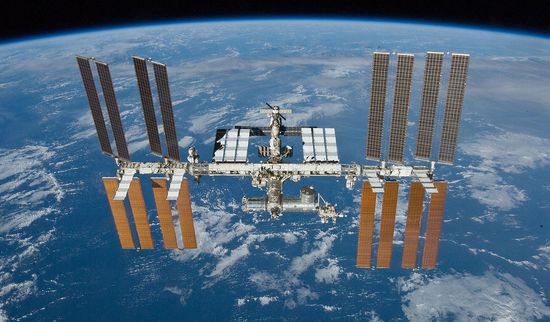Why Is This Foundation Working With NASA to Study Germs in Space?
/
The Sloan Foundation has a unique program studying the ecosystems microbes form in built environments. Now it's funding fellowships with NASA to take a closer look at what microorganisms are up to on the space station.
More than 200 astronauts have been to the International Space Station over the past 18 years, and they’ve brought millions of microscopic space explorers along with them. NASA exhaustively studies the biological effects of space on astronauts, but what about all those little microbes?
That’s the question at the heart of a fellowship recently announced by the Sloan Foundation in partnership with NASA, to determine how microbes colonize, adapt, and evolve in space. The program is accepting proposals and anticipates up to four fellows, each receiving $140,000 over two years.
For NASA, the goal of the program is functional—as the administration explores long-term space flight, as in a journey to Mars, they need to anticipate any unforeseen challenges. While they work hard to clean up astronauts on their way to ISS, a 2015 study found that the space station is crawling with microorganisms. It’s a closed system, but humans are constantly surrounded by tiny microbes in our hair, skin, and inside our guts. NASA wants to better understand what those little guys do inside a bottle with humans over extended periods of time in conditions like zero gravity and prolonged radiation.
Study of our own microbiomes, and what microbes do in our built environments over time has been picking up speed and yielding some fascinating results, in particular as genetic sequencing technology has become more accessible. But it’s still a nascent field, which is why Sloan has made it a funding priority in an effort to boost the work into maturity.
Related:Sloan's Deep (and Kind of Gross) Probe Into the Microbes Crawling All Around You
This is a common play for private science funders, because they have the ability to concentrate funds in a small area of study and have an outsized effect in helping it gain a foothold, demonstrating its value and track record to make it a draw for future research and bigger funding. Sloan has been a big backer of a leading lab at the University of Oregon and funds work to build a better network and repository of data on the subject.
By teaming up with NASA, winners of the new fellowship will gain rare access to an orbiting, enclosed petri dish like no other. They don’t actually get to go up into space, obviously, but NASA has been collecting samples from surfaces and water systems in ISS for more than a decade, and storing the microbes in an archive at the Johnson Space Center in Houston. So that sounds like a horror movie setup if I’ve ever heard one.
The collaboration between Sloan and NASA is part of a longstanding tool the administration has in its tool belt to recruit non-government sources to back up their research. They’re called NASA Space Act Agreements, there are close to 2,000 of them on the books, including partnerships with everyone from Amazon to Virgin Galactic. Full proposals for the Sloan/NASA fellowships are due at the end of November
Related:








